oil temperature MERCEDES-BENZ GLC SUV 2015 Owners Manual
[x] Cancel search | Manufacturer: MERCEDES-BENZ, Model Year: 2015, Model line: GLC SUV, Model: MERCEDES-BENZ GLC SUV 2015Pages: 497, PDF Size: 15.27 MB
Page 7 of 497
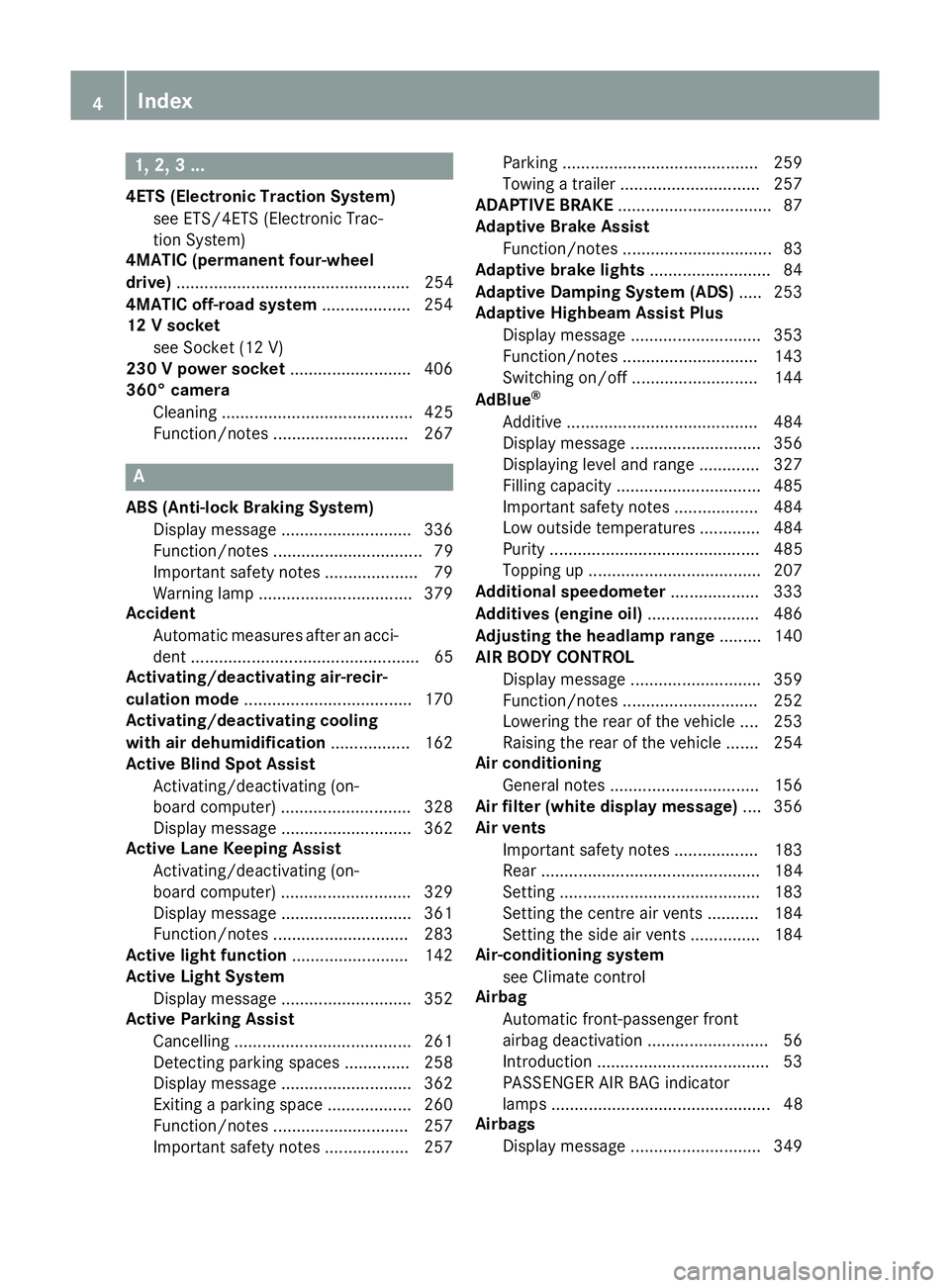
1, 2, 3 ...
4ETS (Electronic Traction System) see ETS/4ETS (Electronic Trac-
tion System)
4MATIC (permanent four-wheel
drive) .................................................. 254
4MATIC off-road system ...................254
12 V socket
see Socket (12 V)
230 V power socket .......................... 406
360° camera
Cleaning ......................................... 425
Function/notes ............................ .267 A
ABS (Anti-lock Braking System) Display message ............................ 336
Function/notes ................................ 79
Important safety notes .................... 79
Warning lamp ................................. 379
Accident
Automatic measures after an acci-
dent ................................................. 65
Activating/deactivating air-recir-
culation mode ................................... .170
Activating/deactivating cooling
with air dehumidification ................. 162
Active Blind Spot Assist
Activating/deactivating (on-
board computer) ............................ 328
Display message ............................ 362
Active Lane Keeping Assist
Activating/deactivating (on-
board computer) ............................ 329
Display message ............................ 361
Function/notes ............................ .283
Active light function ......................... 142
Active Light System
Display message ............................ 352
Active Parking Assist
Cancelling ...................................... 261
Detecting parking spaces .............. 258
Display message ............................ 362
Exiting a parking space .................. 260
Function/notes ............................ .257
Important safety notes .................. 257 Parking .......................................... 259
Towing a trailer .............................. 257
ADAPTIVE BRAKE ................................. 87
Adaptive Brake Assist
Function/notes ................................ 83
Adaptive brake lights .......................... 84
Adaptive Damping System (ADS) ..... 253
Adaptive Highbeam Assist Plus
Display message ............................ 353
Function/notes ............................ .143
Switching on/off ........................... 144
AdBlue ®
Additive ......................................... 484
Display message ............................ 356
Displaying level and range ............. 327
Filling capacity ............................... 485
Important safety notes .................. 484
Low outside temperatures ............. 484
Purity ............................................. 485
Topping up ..................................... 207
Additional speedometer ................... 333
Additives (engine oil) ........................ 486
Adjusting the headlamp range ......... 140
AIR BODY CONTROL
Display message ............................ 359
Function/notes ............................ .252
Lowering the rear of the vehicle .... 253
Raising the rear of the vehicle ....... 254
Air conditioning
General notes ................................ 156
Air filter (white display message) .... 356
Air vents
Important safety notes .................. 183
Rear ............................................... 184
Setting .......................................... .183
Setting the centre air vents ........... 184
Setting the side air vents .............. .184
Air-conditioning system
see Climate control
Airbag
Automatic front-passenger front
airbag deactivatio n .......................... 56
Introduction ..................................... 53
PASSENGER AIR BAG indicator
lamps ............................................... 48
Airbags
Display message ............................ 349 4
Index
Page 19 of 497
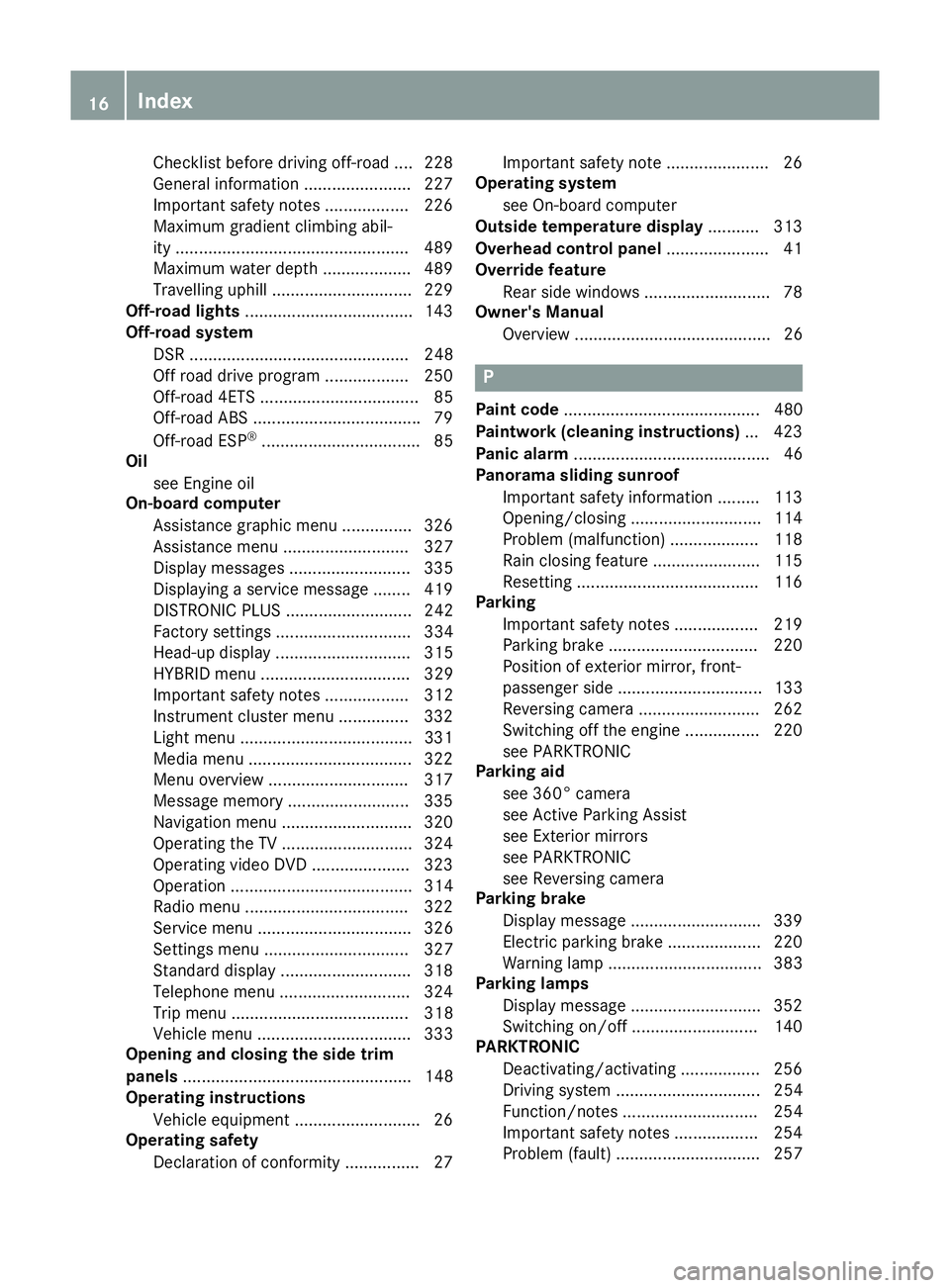
Checklist before driving off-road .... 228
General information ......................
.227
Important safety notes .................. 226
Maximum gradient climbing abil-
ity ................................................. .489
Maximum water depth ................... 489
Travelling uphill .............................. 229
Off-road lights ................................... .143
Off-road system
DSR ............................................... 248
Off road drive program .................. 250
Off-road 4ETS .................................. 85
Off-road ABS ................................... .79
Off-road ESP ®
..................................85
Oil
see Engine oil
On-board computer
Assistance graphic menu ............... 326
Assistance menu ........................... 327
Display messages .......................... 335
Displaying a service message ........ 419
DISTRONIC PLUS ........................... 242
Factory settings ............................. 334
Head-up display ............................. 315
HYBRID menu ................................ 329
Important safety notes .................. 312
Instrument cluster menu ............... 332
Light menu .....................................3 31
Media menu ................................... 322
Menu overview .............................. 317
Message memory .......................... 335
Navigation menu ............................ 320
Operating the TV ............................ 324
Operating video DVD ..................... 323
Operation ....................................... 314
Radio menu ................................... 322
Service menu ................................. 326
Settings menu ............................... 327
Standard display ............................ 318
Telephone menu ............................ 324
Trip menu ...................................... 318
Vehicle menu ................................. 333
Opening and closing the side trim
panels ................................................. 148
Operating instructions
Vehicle equipment ........................... 26
Operating safety
Declaration of conformity ................ 27 Important safety note .....................
.26
Operating system
see On-board computer
Outside temperature display ........... 313
Overhead control panel ......................41
Override feature
Rear side windows ........................... 78
Owner's Manual
Overview .......................................... 26 P
Paint code .......................................... 480
Paintwork (cleaning instructions) ... 423
Panic alarm .......................................... 46
Panorama sliding sunroof
Important safety information ......... 113
Opening/closing ............................1 14
Problem (malfunction) ................... 118
Rain closing feature ....................... 115
Resetting ....................................... 116
Parking
Important safety notes .................. 219
Parking brake ................................ 220
Position of exterior mirror, front-
passenger sid e............................... 133
Reversing camera .......................... 262
Switching off the engine ................ 220
see PARKTRONIC
Parking aid
see 360° camera
see Active Parking Assist
see Exterior mirrors
see PARKTRONIC
see Reversing camera
Parking brake
Display message ............................ 339
Electric parking brake .................... 220
Warning lamp ................................. 383
Parking lamps
Display message ............................ 352
Switching on/of f........................... 140
PARKTRONIC
Deactivating/activating ................. 256
Driving system ............................... 254
Function/note s............................. 254
Important safety notes .................. 254
Problem (fault) ............................... 257 16
Index
Page 215 of 497
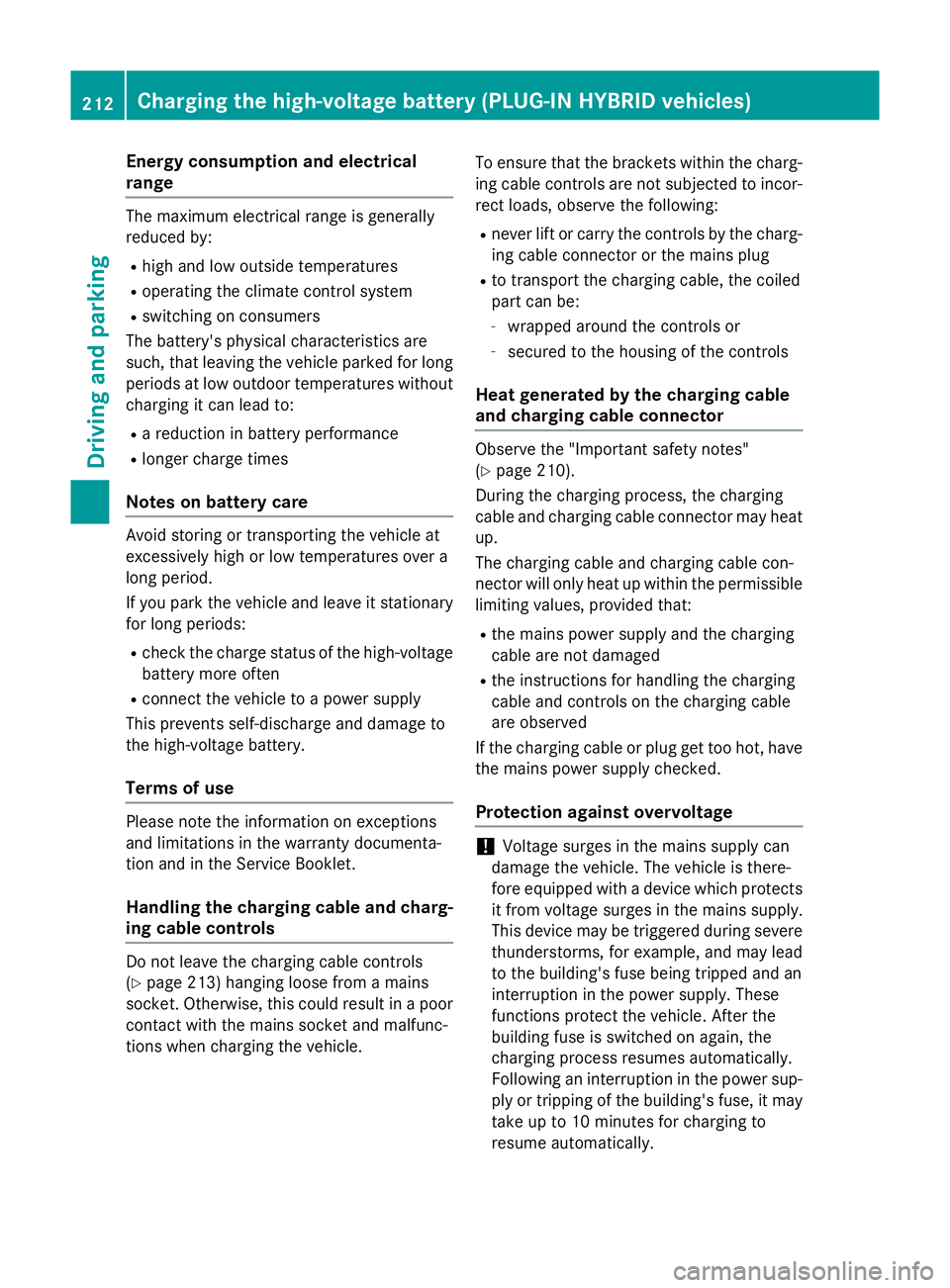
Energy consumption and electrical
range The maximum electrical range is generally
reduced by:
R high and low outside temperatures
R operating the climate control system
R switching on consumers
The battery's physical characteristics are
such, that leaving the vehicle parked for long
periods at low outdoor temperatures without charging it can lead to:
R a reduction in battery performance
R longer charge times
Notes on battery care Avoid storing or transporting the vehicle at
excessively high or low temperatures over a
long period.
If you park the vehicle and leave it stationary for long periods:
R check the charge status of the high-voltage
battery more often
R connect the vehicle to a power supply
This prevents self-discharge and damage to
the high-voltage battery.
Terms of use Please note the information on exceptions
and limitations in the warranty documenta-
tion and in the Service Booklet.
Handling the charging cable and charg- ing cable controls Do not leave the charging cable controls
(Y page 213) hanging loose from a mains
socket. Otherwise, this could result in a poor contact with the mains socket and malfunc-
tions when charging the vehicle. To ensure that the brackets within the charg-
ing cable controls are not subjected to incor-
rect loads, observe the following:
R never lift or carry the controls by the charg-
ing cable connector or the mains plug
R to transport the charging cable, the coiled
part can be:
- wrapped around the controls or
- secured to the housing of the controls
Heat generated by the charging cable
and charging cable connector Observe the "Important safety notes"
(Y page 210).
During the charging process, the charging
cable and charging cable connector may heat
up.
The charging cable and charging cable con-
nector will only heat up within the permissible limiting values, provided that:
R the mains power supply and the charging
cable are not damaged
R the instructions for handling the charging
cable and controls on the charging cable
are observed
If the charging cable or plug get too hot, have the mains power supply checked.
Protection against overvoltage !
Voltage surges in the mains supply can
damage the vehicle. The vehicle is there-
fore equipped with a device which protects
it from voltage surges in the mains supply.
This device may be triggered during severe
thunderstorms, for example, and may lead
to the building's fuse being tripped and an
interruption in the power supply. These
functions protect the vehicle. After the
building fuse is switched on again, the
charging process resumes automatically.
Following an interruption in the power sup-
ply or tripping of the building's fuse, it may take up to 10 minutes for charging to
resume automatically. 212
Charging the high-voltage battery (PLUG-IN HYBRID vehicles)Driving and parking
Page 419 of 497
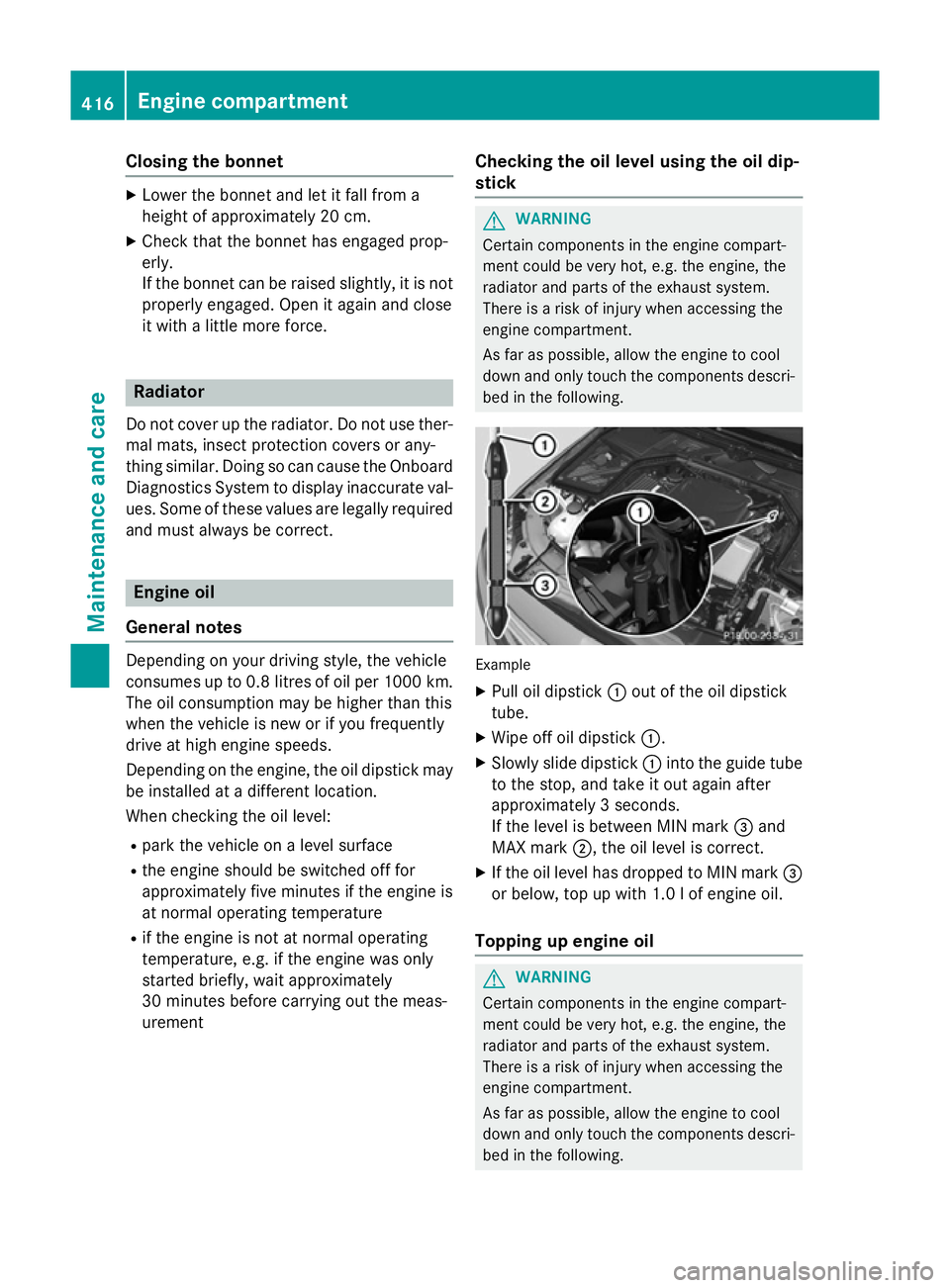
Closing the bonnet
X
Lower the bonnet and let it fall from a
height of approximately 20 cm.
X Check that the bonnet has engaged prop-
erly.
If the bonnet can be raised slightly, it is not
properly engaged. Open it again and close
it with a little more force. Radiator
Do not cover up the radiator. Do not use ther-
mal mats, insect protection covers or any-
thing similar. Doing so can cause the Onboard Diagnostics System to display inaccurate val-
ues. Some of these values are legally required
and must always be correct. Engine oil
General notes Depending on your driving style, the vehicle
consumes up to 0.8 litres of oil per 1000 km.
The oil consumption may be higher than this
when the vehicle is new or if you frequently
drive at high engine speeds.
Depending on the engine, the oil dipstick may
be installed at a different location.
When checking the oil level:
R park the vehicle on a level surface
R the engine should be switched off for
approximately five minutes if the engine is
at normal operating temperature
R if the engine is not at normal operating
temperature, e.g. if the engine was only
started briefly, wait approximately
30 minutes before carrying out the meas-
urement Checking the oil level using the oil dip-
stick G
WARNING
Certain components in the engine compart-
ment could be very hot, e.g. the engine, the
radiator and parts of the exhaust system.
There is a risk of injury when accessing the
engine compartment.
As far as possible, allow the engine to cool
down and only touch the components descri- bed in the following. Example
X Pull oil dipstick :out of the oil dipstick
tube.
X Wipe off oil dipstick :.
X Slowly slide dipstick :into the guide tube
to the stop, and take it out again after
approximately 3 seconds.
If the level is between MIN mark =and
MAX mark ;, the oil level is correct.
X If the oil level has dropped to MIN mark =
or below, top up with 1.0 l of engine oil.
Topping up engine oil G
WARNING
Certain components in the engine compart-
ment could be very hot, e.g. the engine, the
radiator and parts of the exhaust system.
There is a risk of injury when accessing the
engine compartment.
As far as possible, allow the engine to cool
down and only touch the components descri- bed in the following. 416
Engine compartmentMaintenance and care
Page 486 of 497

As a temporary measure, if the recommen-
ded fuel is not available, you may also use
regular unleaded petrol with an octane rat-
ing of 91 ROZ. Doing so results in higher
fuel consumption and significantly reduced performance. Never refuel using fuel with a lower RON.
Fuel of this specification may contain up to
10% ethanol.
Fuel that does not conform to EN 228 or
E DIN 51626–1 can lead to increased wear
as well as damage to the engine and
exhaust system.
Additives ! Operating the engine with fuel additives
added later can lead to engine failure. Do
not mix fuel additives with fuel. This does
not include additives for the removal and
prevention of residue build-up. Petrol must only be mixed with additives recommended
by Mercedes-Benz. Observe the instruc-
tions for use in the product description.
More information about recommended
additives can be obtained from any
Mercedes-Benz Service Centre.
Mercedes-Benz recommends that you use
fuel brands that have additives.
The quality of the fuel available in some coun- tries may not be sufficient. Residue could
build up in the injection system as a result. In
this case, in consultation with a Mercedes-
Benz Service Centre, the petrol may be mixed
with the cleaning additive recommended by
Mercedes-Benz. Always observe the notes
and mixing ratios specified on the container.
Diesel Fuel grade
G
WARNING
If you mix diesel fuel with petrol, the flash
point of this fuel mixture is lower than that of pure diesel fuel. When the engine is running,
components in the exhaust system may over-
heat unnoticed. There is a risk of fire. Never refuel with petrol. Never add petrol to
diesel fuel.
! When refuelling, only use diesel fuel that
conforms to the European standard EN 590
or is of equivalent quality. Fuel that does
not conform to EN 590 can lead to
increased wear as well as damage to the
engine and exhaust system.
! Do not use the following:
R marine diesel
R heating oil
R bio-diesel
R vegetable oil
R petrol
R paraffin
R kerosene
Do not mix such fuels with diesel fuel and
do not use any special additives. Other-
wise, engine damage may occur.
! In countries outside the EU, only use low-
sulphur Euro diesel with a sulphur content
of under 50 ppm. Otherwise, the emission
control system could be damaged.
Usually you will find information about the
fuel grade on the pump. If you cannot find the
label on the petrol pump, ask the filling sta-
tion staff.
Information on refuelling (Y page 204).
Low outside temperatures
In winter months, diesel fuel with an improved
cold flow quality is available. In Europe, the
EN 590 standard defines various climate-
dependent temperature categories. Malfunc- tions can be avoided by refuelling with diesel
fuel that corresponds to the climatic specifi-
cations outlined in EN 590. At unusually low
outside temperatures, it is possible that the
flow characteristics of the diesel fuel could be insufficient. Accordingly, diesel fuel from
warmer areas may not be suitable for opera-
tion in colder climatic conditions. Service products and capacities
483Technical data Z
Page 487 of 497
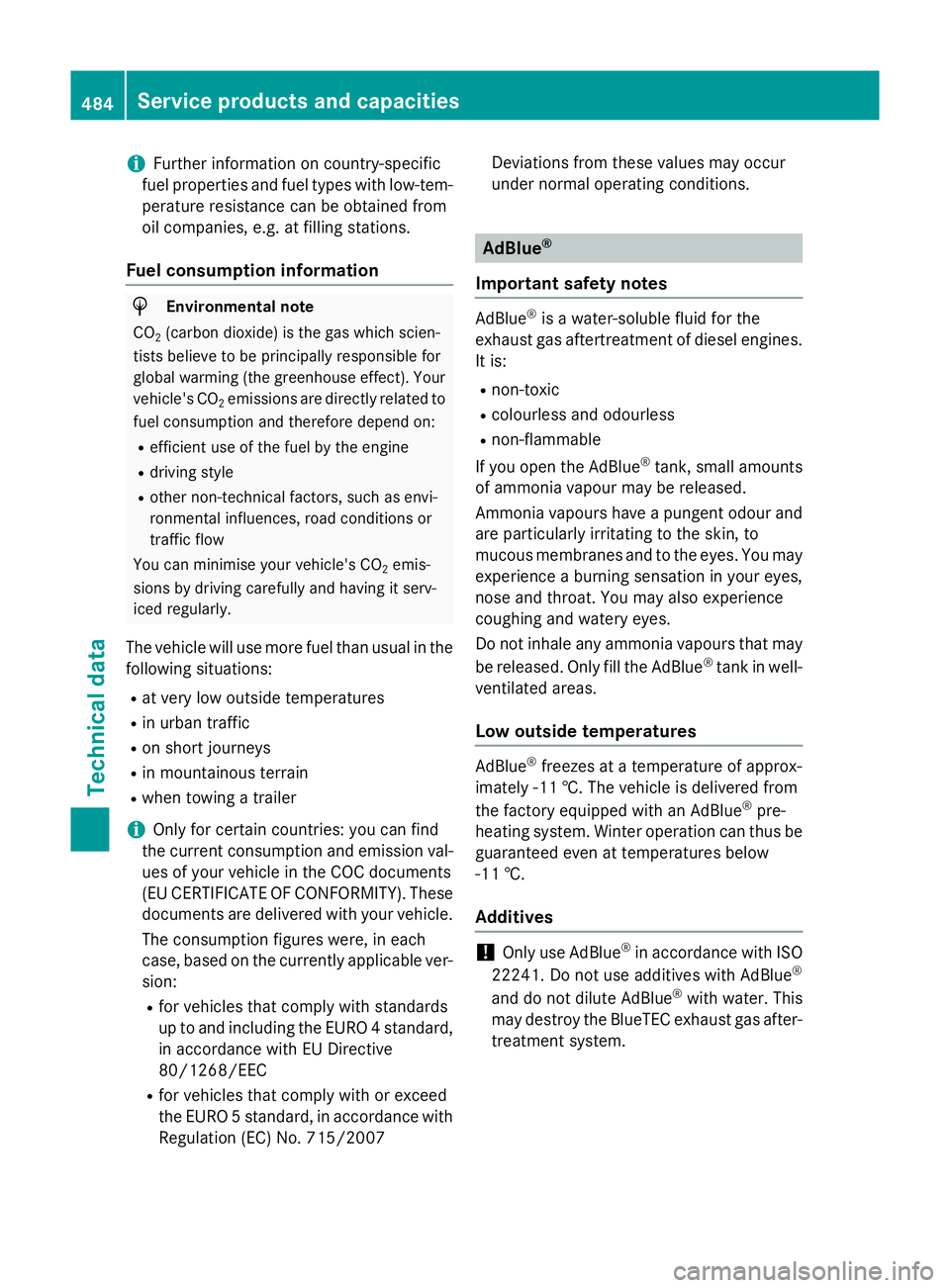
i
Further information on country-specific
fuel properties and fuel types with low-tem-
perature resistance can be obtained from
oil companies, e.g. at filling stations.
Fuel consumption information H
Environmental note
CO 2(carbon dioxide) is the gas which scien-
tists believe to be principally responsible for
global warming (the greenhouse effect). Your
vehicle's CO 2emissions are directly related to
fuel consumption and therefore depend on:
R efficient use of the fuel by the engine
R driving style
R other non-technical factors, such as envi-
ronmental influences, road conditions or
traffic flow
You can minimise your vehicle's CO 2emis-
sions by driving carefully and having it serv-
iced regularly.
The vehicle will use more fuel than usual in the following situations:
R at very low outside temperatures
R in urban traffic
R on short journeys
R in mountainous terrain
R when towing a trailer
i Only for certain countries: you can find
the current consumption and emission val-
ues of your vehicle in the COC documents
(EU CERTIFICATE OF CONFORMITY). These documents are delivered with your vehicle.
The consumption figures were, in each
case, based on the currently applicable ver- sion:
R for vehicles that comply with standards
up to and including the EURO 4 standard,
in accordance with EU Directive
80/1268/EEC
R for vehicles that comply with or exceed
the EURO 5 standard, in accordance with Regulation (EC) No. 715/2007 Deviations from these values may occur
under normal operating conditions. AdBlue
®
Important safety notes AdBlue
®
is a water-soluble fluid for the
exhaust gas aftertreatment of diesel engines. It is:
R non-toxic
R colourless and odourless
R non-flammable
If you open the AdBlue ®
tank, small amounts
of ammonia vapour may be released.
Ammonia vapours have a pungent odour and
are particularly irritating to the skin, to
mucous membranes and to the eyes. You may experience a burning sensation in your eyes,
nose and throat. You may also experience
coughing and watery eyes.
Do not inhale any ammonia vapours that may
be released. Only fill the AdBlue ®
tank in well-
ventilated areas.
Low outside temperatures AdBlue
®
freezes at a temperature of approx-
imately -11 †. The vehicle is delivered from
the factory equipped with an AdBlue ®
pre-
heating system. Winter operation can thus be
guaranteed even at temperatures below
-11 †.
Additives !
Only use AdBlue ®
in accordance with ISO
22241. Do not use additives with AdBlue ®
and do not dilute AdBlue ®
with water. This
may destroy the BlueTEC exhaust gas after-
treatment system. 484
Service products and capacitiesTechnical data
Page 489 of 497
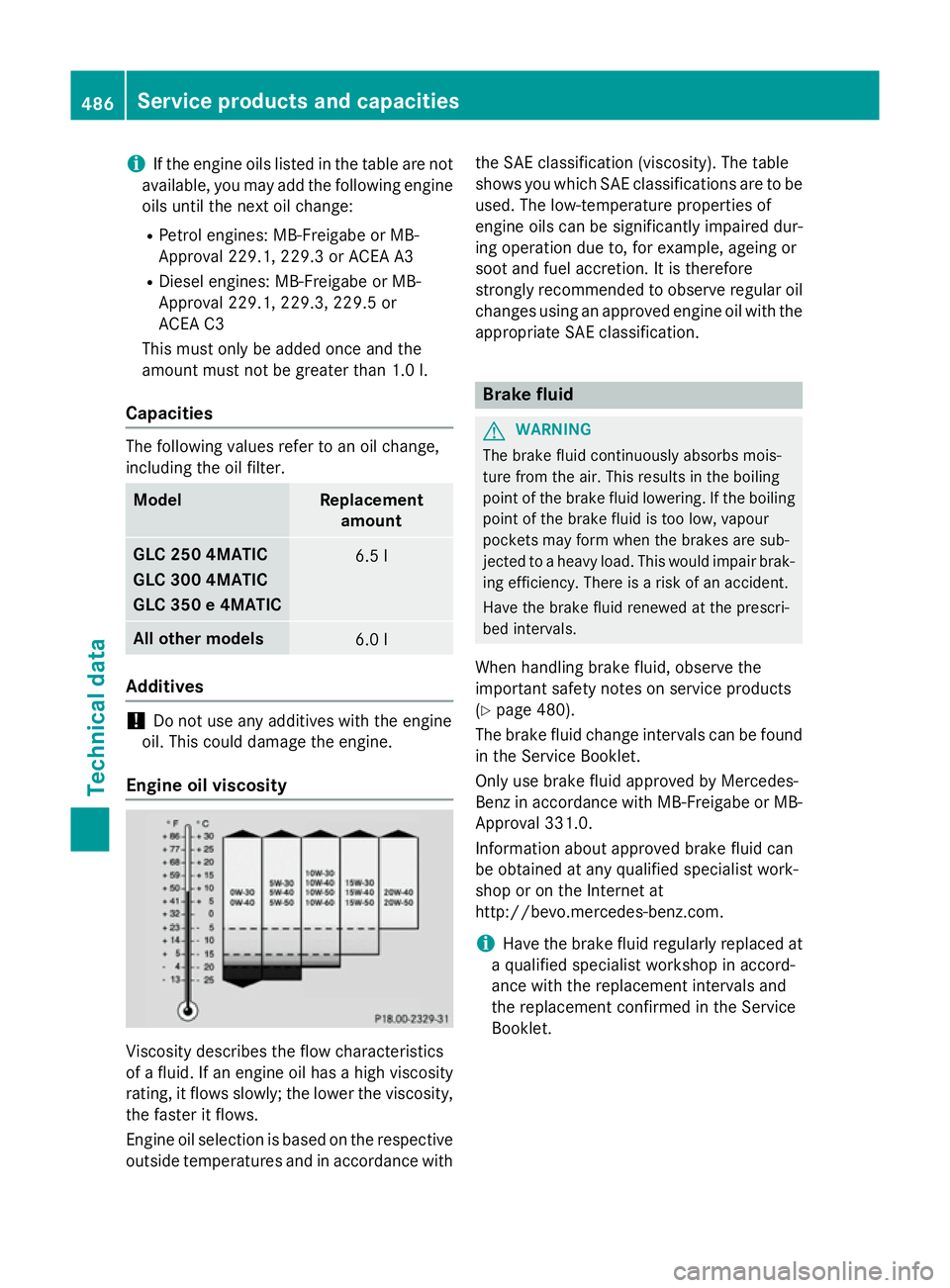
i
If the engine oils listed in the table are not
available, you may add the following engine
oils until the next oil change:
R Petrol engines: MB-Freigabe or MB-
Approval 229.1, 229.3 or ACEA A3
R Diesel engines: MB-Freigabe or MB-
Approval 229.1, 229.3, 229.5 or
ACEA C3
This must only be added once and the
amount must not be greater than 1.0 l.
Ca pacities The following values refer to an oil change,
including the oil filter.
Model Replacement
amount GLC 250 4MATIC
GLC 300 4MATIC
GLC 350 e 4MATIC 6.5 l
All other models
6.0 l
Additives
!
Do not use any additives with the engine
oil. This could damage the engine.
Engine oil viscosity Viscosity describes the flow characteristics
of a fluid. If an engine oil has a high viscosity
rating, it flows slowly; the lower the viscosity,
the faster it flows.
Engine oil selection is based on the respective outside temperatures and in accordance with the SAE classification (viscosity). The table
shows you which SAE classifications are to be
used. The low-temperature properties of
engine oils can be significantly impaired dur-
ing operation due to, for example, ageing or
soot and fuel accretion. It is therefore
strongly recommended to observe regular oil changes using an approved engine oil with the
appropriate SAE classification. Brake fluid
G
WARNING
The brake fluid continuously absorbs mois-
ture from the air. This results in the boiling
point of the brake fluid lowering. If the boiling
point of the brake fluid is too low, vapour
pockets may form when the brakes are sub-
jected to a heavy load. This would impair brak- ing efficiency. There is a risk of an accident.
Have the brake fluid renewed at the prescri-
bed intervals.
When handling brake fluid, observe the
important safety notes on service products
(Y page 480).
The brake fluid change intervals can be found in the Service Booklet.
Only use brake fluid approved by Mercedes-
Benz in accordance with MB-Freigabe or MB-Approval 331.0.
Information about approved brake fluid can
be obtained at any qualified specialist work-
shop or on the Internet at
http://bevo.mercedes-benz.com.
i Have the brake fluid regularly replaced at
a qualified specialist workshop in accord-
ance with the replacement intervals and
the replacement confirmed in the Service
Booklet. 486
Service products and capacitiesTechnical data
Page 490 of 497
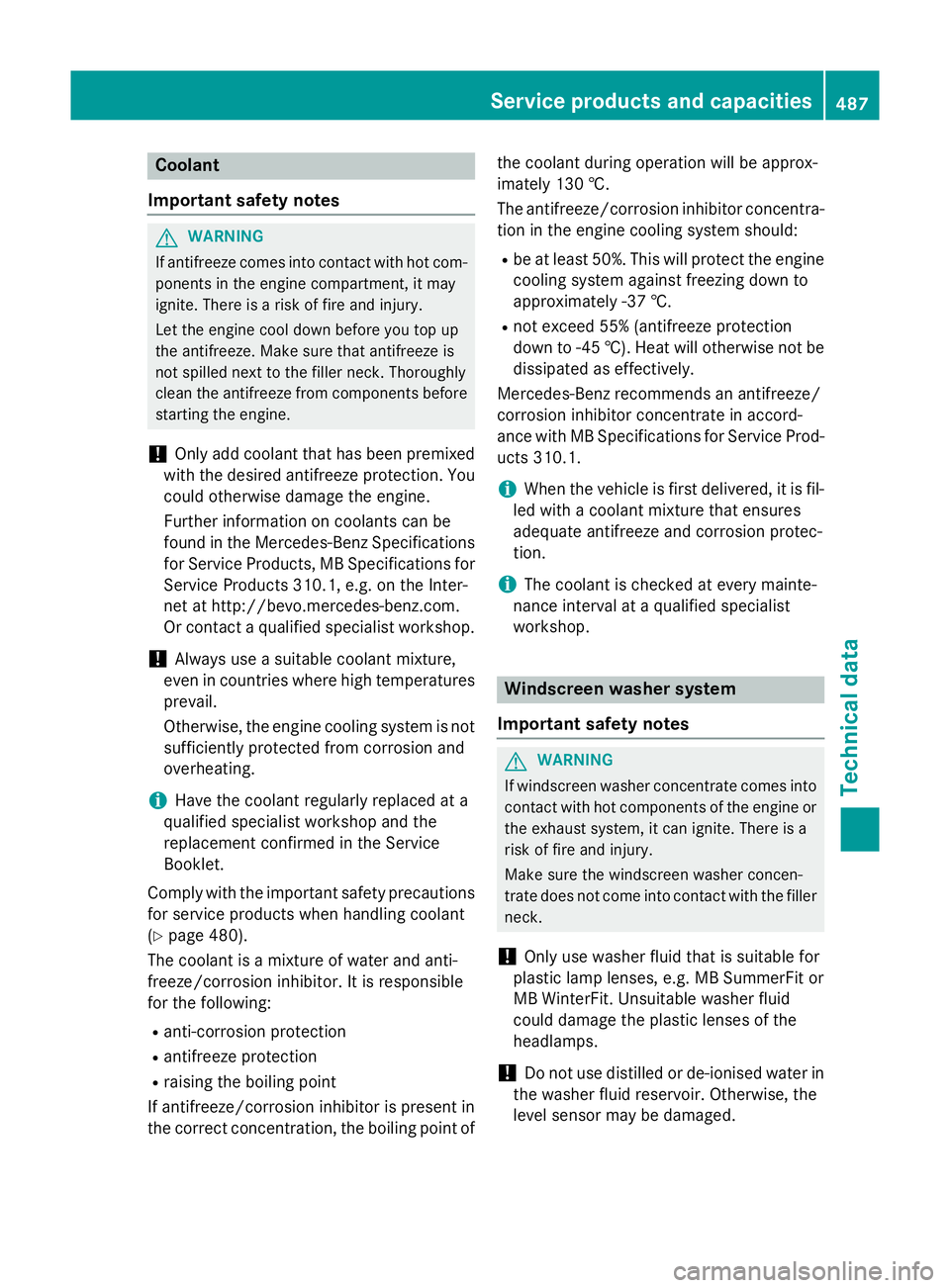
Coolant
Important safety notes G
WARNING
If antifreeze comes into contact with hot com- ponents in the engine compartment, it may
ignite. There is a risk of fire and injury.
Let the engine cool down before you top up
the antifreeze. Make sure that antifreeze is
not spilled next to the filler neck. Thoroughly
clean the antifreeze from components before
starting the engine.
! Only add coolant that has been premixed
with the desired antifreeze protection. You
could otherwise damage the engine.
Further information on coolants can be
found in the Mercedes-Benz Specifications for Service Products, MB Specifications for Service Products 310.1, e.g. on the Inter-
net at http://bevo.mercedes-benz.co m.
Or contact a qualified specialist workshop.
! Always use a suitable coolant mixture,
even in countries where high temperatures prevail.
Otherwise, the engine cooling system is not
sufficiently protected from corrosion and
overheating.
i Have the coolant regularly replaced at a
qualified specialist workshop and the
replacement confirmed in the Service
Booklet.
Comply with the important safety precautions for service products when handling coolant
(Y page 480).
The coolant is a mixture of water and anti-
freeze/corrosion inhibitor. It is responsible
for the following:
R anti-corrosion protection
R antifreeze protection
R raising the boiling point
If antifreeze/corrosion inhibitor is present in
the correct concentration, the boiling point of the coolant during operation will be approx-
imately 130 †.
The antifreeze/corrosion inhibitor concentra-
tion in the engine cooling system should:
R be at least 50%. This will protect the engine
cooling system against freezing down to
approximately -37 †.
R not exceed 55% (antifreeze protection
down to -45 †). Heat will otherwise not be
dissipated as effectively.
Mercedes-Benz recommends an antifreeze/
corrosion inhibitor concentrate in accord-
ance with MB Specifications for Service Prod-
ucts 310.1.
i When the vehicle is first delivered, it is fil-
led with a coolant mixture that ensures
adequate antifreeze and corrosion protec-
tion.
i The coolant is checked at every mainte-
nance interval at a qualified specialist
workshop. Windscreen washer system
Important safety notes G
WARNING
If windscreen washer concentrate comes into contact with hot components of the engine or
the exhaust system, it can ignite. There is a
risk of fire and injury.
Make sure the windscreen washer concen-
trate does not come into contact with the filler neck.
! Only use washer fluid that is suitable for
plastic lamp lenses, e.g. MB SummerFit or
MB WinterFit. Unsuitable washer fluid
could damage the plastic lenses of the
headlamps.
! Do not use distilled or de-ionised water in
the washer fluid reservoir. Otherwise, the
level sensor may be damaged. Service products and capacities
487Technical data Z